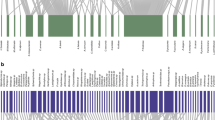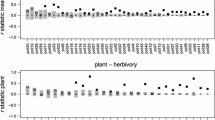Abstract
Interaction webs, or networks, define how the members of two or more trophic levels interact. However, the traits that mediate network structure have not been widely investigated. Generally, the mechanism that determines plant-pollinator partnerships is thought to involve the matching of a suite of species traits (such as abundance, phenology, morphology) between trophic levels. These traits are often unknown or hard to measure, but may reflect phylogenetic history. We asked whether morphological traits or phylogenetic history were more important in mediating network structure in mutualistic plant-pollinator interaction networks from Western Canada. At the plant species level, sexual system, growth form, and flower symmetry were the most important traits. For example species with radially symmetrical flowers had more connections within their modules (a subset of species that interact more among one another than outside of the module) than species with bilaterally symmetrical flowers. At the pollinator species level, social species had more connections within and among modules. In addition, larger pollinators tended to be more specialized. As traits mediate interactions and have a phylogenetic signal, we found that phylogenetically close species tend to interact with a similar set of species. At the network level, patterns were weak, but we found increasing functional trait and phylogenetic diversity of plants associated with increased weighted nestedness. These results provide evidence that both specific traits and phylogenetic history can contribute to the nature of mutualistic interactions within networks, but they explain less variation between networks.



Similar content being viewed by others
References
Almeida-Neto M, Ulrich W (2011) A straightforward computational approach for measuring nestedness using quantitative matrices. Environ Model Softw 26:173–178
Bascompte J, Jordano P (2007) Plant-animal mutualistic networks: the architecture of biodiversity. Annu Rev Ecol Evol Syst 38:567–593
Bascompte J, Jordano P, Melián CJ, Olesen JM (2003) The nested assembly of plant–animal mutualistic networks. Proc Natl Acad Sci 100:9383–9387
Bascompte J, Jordano P, Olesen JM (2006) Asymmetric coevolutionary networks facilitate biodiversity maintenance. Science 312:431–433
Bates D, Maechler M, Bolker B, et al. (2012) lme4: linear mixed-effects models using S4 classes. R package version 0.999999-0
Blomberg SP, Garland T Jr, Ives AR (2003) Testing for phylogenetic signal in comparative data: behavioral traits are more labile. Evolution 57:717–745
Blüthgen N, Menzel F, Blüthgen N (2006) Measuring specialization in species interaction networks. BMC Ecol 6:9. doi:10.1186/1472-6785-6-9
Botta-Dukát Z (2005) Rao’s quadratic entropy as a measure of functional diversity based on multiple traits. J Veg Sci 16:533–540
Bronstein JL, Alarcón R, Geber M (2006) The evolution of plant–insect mutualisms. New Phytol 172:412–428
Cagnolo L, Salvo A, Valladares G (2011) Network topology: patterns and mechanisms in plant-herbivore and host-parasitoid food webs. J Anim Ecol 80:342–351
Cane JH (1987) Estimation of bee size using intertegular span (Apoidea). J Kans Entomol Soc 60:145-147
Cane JH, Sipes S (2006) Characterizing floral specialization by bees: analytical methods and a revised lexicon for oligolecty. Plant-Pollinator Interact Spec Gen Univ Chic Press Chic Lond, pp 99–122
Cardinale BJ, Duffy JE, Gonzalez A, et al. (2012) Biodiversity loss and its impact on humanity. Nature 486:59–67
Chamberlain SA, Holland JN (2009) Quantitative synthesis of context dependency in ant-plant protection mutualisms. Ecology 90:2384–2392. doi:10.1890/08-1490.1
Clarke D, Whitney H, Sutton G, Robert D (2013) Detection and learning of floral electric fields by bumblebees. Science 340:66–69
Cortis P, Vereecken N, Schiestl F, et al. (2009) Pollinator convergence and the nature of species’ boundaries in sympatric Sardinian Ophrys (Orchidaceae). Ann Bot 104:497–506
Cribari-neto F, Zeileis A (2010) Beta regression in R. J Stat Softw 34:1–24
Danieli-Silva A, De Souza JMT, Donatti AJ, et al. (2012) Do pollination syndromes cause modularity and predict interactions in a pollination network in tropical high-altitude grasslands? Oikos 121:35–43
Donatti CI, Guimarães PR, Galetti M, et al. (2011) Analysis of a hyper-diverse seed dispersal network: modularity and underlying mechanisms. Ecol Lett 14:773–781
Dormann CF (2011) How to be a specialist? Quantifying specialisation in pollination networks. Netw Biol 1:1–20
Dunne JA, Williams RJ, Martinez ND (2002) Network structure and biodiversity loss in food webs: robustness increases with connectance. Ecol Lett 5:558–567
Elle E, Elwell SL, Gielens GA (2012) The use of pollination networks in conservation. 1. Botany 90:525–534
Encinas-Viso F, Revilla TA, Etienne RS (2012) Phenology drives mutualistic network structure and diversity. Ecol Lett 15:198–208
Flora of North America Editorial (2002) Flora of North America: Magnoliophyta: Commelinidae (in Part): Cyperaceae, vol 23. Oxford University Press, Oxford
Fontaine C, Collin CL, Dajoz I (2008) Generalist foraging of pollinators: diet expansion at high density. J Ecol 96:1002–1010
Fritz SA, Purvis A (2010) Selectivity in mammalian extinction risk and threat types: a new measure of phylogenetic signal strength in binary traits. Conserv Biol 24:1042–1051
Gibson RH, Knott B, Eberlein T, Memmott J (2011) Sampling method influences the structure of plant-pollinator networks. Oikos 120:822–831
Greenleaf SS, Williams NM, Winfree R, Kremen C (2007) Bee foraging ranges and their relationship to body size. Oecologia 153:589–596
Guimera R, Amaral LAN (2005a) Functional cartography of complex metabolic networks. Nature 433:895–900
Guimera R, Amaral LAN (2005b) Cartography of complex networks: modules and universal roles. J Stat Mech Theory Exp 2005:P02001
Harmon LJ, Glor RE (2010) Poor statistical performance of the Mantel test in phylogenetic comparative analyses. Evolution 64:2173–2178
Hedges SB, Dudley J, Kumar S (2006) TimeTree: a public knowledge-base of divergence times among organisms. Bioinformatics 22:2971–2972
Junker RR, Höcherl N, Blüthgen N (2010) Responses to olfactory signals reflect network structure of flower-visitor interactions. J Anim Ecol 79:818–823
Junker RR, Blüthgen N, Brehm T, et al. (2013) Specialization on traits as basis for the niche-breadth of flower visitors and as structuring mechanism of ecological networks. Funct Ecol 27:329–341. doi:10.1111/1365-2435.12005
Klinkenberg B (2012) E-Flora BC: atlas of the plants of British Columbia. http://www.eflora.bc.ca
Laliberté E, Legendre P (2010) A distance-based framework for measuring functional diversity from multiple traits. Ecology 91:299–305
Maddison WP, Maddison DR (2011) Mesquite: a modular system for evolutionary analysis. Version 2.75. http://mesquiteproject.org
Michener CD (2007) The bees of the world, 2nd edn. John Hopkins University Press, Baltimore
Oksanen J, Blanchet FG, Kindt R, et al. (2013) vegan: community ecology package. R package version 20-6. http://cran.r-project.org/web/packages/vegan/
Olesen JM, Bascompte J, Dupont YL, Jordano P (2007) The modularity of pollination networks. Proc Natl Acad Sci 104:19891–19896
Paine RT (1980) Food webs: linkage, interaction strength and community infrastructure. J Anim Ecol 49:667–685
Paradis E, Claude J, Strimmer K (2004) APE: analyses of phylogenetics and evolution in R language. Bioinformatics 20:289–290
Rezende EL, Lavabre JE, Guimarães PR, et al. (2007) Non-random coextinctions in phylogenetically structured mutualistic networks. Nature 448:925–928
Sabo JL, Bastow JL, Power ME (2002) Length-mass relationships for adult aquatic and terrestrial invertebrates in a California watershed. J North Am Benthol Soc 21:336–343
Santamaría L, Rodríguez-Gironés MA (2007) Linkage rules for plant–pollinator networks: trait complementarity or exploitation barriers? PLoS Biol 5:e31. doi:10.1371/journal.pbio.0050031
Stang M, Klinkhamer PG, Van Der Meijden E (2006) Size constraints and flower abundance determine the number of interactions in a plant–flower visitor web. Oikos 112:111–121
Thébault E, Fontaine C (2010) Stability of ecological communities and the architecture of mutualistic and trophic networks. Science 329:853–856
Tylianakis JM, Tscharntke T, Lewis OT (2007) Habitat modification alters the structure of tropical host–parasitoid food webs. Nature 445:202–205
Vázquez DP, Melián CJ, Williams NM, et al. (2007) Species abundance and asymmetric interaction strength in ecological networks. Oikos 116:1120–1127
Vázquez DP, Chacoff NP, Cagnolo L (2009) Evaluating multiple determinants of the structure of plant-animal mutualistic networks. Ecology 90:2039–2046
Webb CO, Donoghue MJ (2004) Phylomatic: tree assembly for applied phylogenetics. Mol Ecol Notes 5:181–183
Webb CO, Ackerly DD, Kembel SW (2008) Phylocom: software for the analysis of phylogenetic community structure and trait evolution. Bioinformatics 24:2098–2100
Wikstrom N, Savolainen V, Chase MW (2001) Evolution of the angiosperms: calibrating the family tree. Proc R Soc B Biol Sci 268:2211–2220. doi:10.1098/rspb.2001.1782
Woodward G, Ebenman B, Emmerson M, et al. (2005) Body size in ecological networks. Trends Ecol Evol 20:402–409
Acknowledgments
We thank one anonymous reviewer and Handling Editor Steve Johnson for suggestions that greatly improved this manuscript. We acknowledge funding from NSERC-CANPOLIN, the Canadian Pollination Initiative. Additional funding was provided by an Alberta Conservation Association Grants in Biodiversity Program grant to Megan Evans, an Agriculture and AgriFood Canada grant to Mark Wonnick, NSERC-DG to Ralph Cartar, and NSERC-DG to Elizabeth Elle. This is publication 96 of NSERC-CANPOLIN. The experiments comply with the current laws of the country (Canada) in which the experiments were performed.
Author information
Authors and Affiliations
Corresponding author
Additional information
Communicated by Steven D. Johnson.
Electronic supplementary material
Below is the link to the electronic supplementary material.
Rights and permissions
About this article
Cite this article
Chamberlain, S.A., Cartar, R.V., Worley, A.C. et al. Traits and phylogenetic history contribute to network structure across Canadian plant–pollinator communities. Oecologia 176, 545–556 (2014). https://doi.org/10.1007/s00442-014-3035-2
Received:
Accepted:
Published:
Issue Date:
DOI: https://doi.org/10.1007/s00442-014-3035-2




